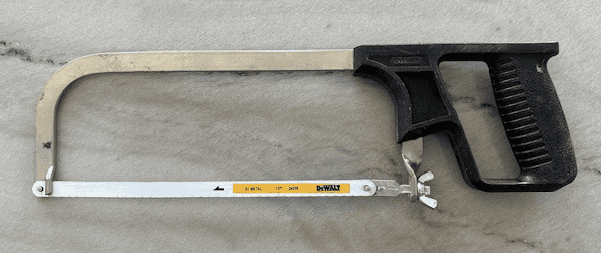A hacksaw is a fine-toothed saw, primarily made for cutting metal. The typical hacksaw consists of a metal frame with a blade that is held in tension, allowing for precise and controlled cuts. It is a versatile tool used in metalworking, woodworking, and plumbing.
History
The hacksaw has its origins in the early 19th century when the need for cutting metal efficiently became apparent. Initially, these saws were simple frames with blades made of carbon steel. Over time, improvements in metallurgy and design have led to the modern hacksaws we use today, featuring adjustable frames and high-speed steel blades.
Types of Hacksaws
- Adjustable Frame Hacksaw
- Fixed Frame Hacksaw
- Mini Hacksaw
- Junior Hacksaw
- Electric Hacksaw
Hacksaw Key Features
- Frame Material: Typically made from steel or aluminum for durability.
- Blade Length: Common lengths are 10 to 12 inches.
- Teeth per Inch (TPI): Higher TPI for fine cuts, lower TPI for rough cuts.
- Adjustable Tension: Allows for precise blade tensioning.
- Ergonomic Handle: Designed for comfort and control during use.
Choosing the Right Hacksaw
When choosing a hacksaw, consider the material you will be cutting. For metal cutting, a saw with a high TPI blade is ideal, while for general purpose use, a lower TPI blade might be more suitable. The frame should be sturdy and comfortable to hold, with an adjustable tension feature to accommodate different blade types and thicknesses.
Hacksaw Recommendations
Proper Use and Techniques
To use a hacksaw effectively, secure the material you are cutting in a vise or clamp. Use smooth, steady strokes, allowing the saw to do the work without applying excessive force. Start with a slow stroke to establish the cut, then proceed with full-length strokes to complete the cut. Always ensure the blade is properly tensioned to prevent bending or breaking.
Maintenance and Care
Proper maintenance of your hacksaw includes regularly checking the blade for wear and replacing it when necessary. Keep the frame clean and free from debris, and lubricate the tensioning mechanism to ensure smooth operation. Store the hacksaw in a dry place to prevent rust and corrosion.
Hacksaw Safety Tips
- Always wear safety goggles to protect your eyes from metal shavings.
- Ensure the material being cut is securely clamped to prevent movement.
- Use the correct blade for the material to avoid excessive force.
- Keep your hands away from the cutting path to prevent injury.
- Inspect the saw and blade for damage before each use.
Conclusion
A hacksaw is an indispensable tool for any DIY enthusiast or professional. By understanding the different types, key features, and proper techniques for use and maintenance, you can ensure efficient and safe cutting. Always prioritize safety and choose the right hacksaw for your specific needs to achieve the best results in your projects.


